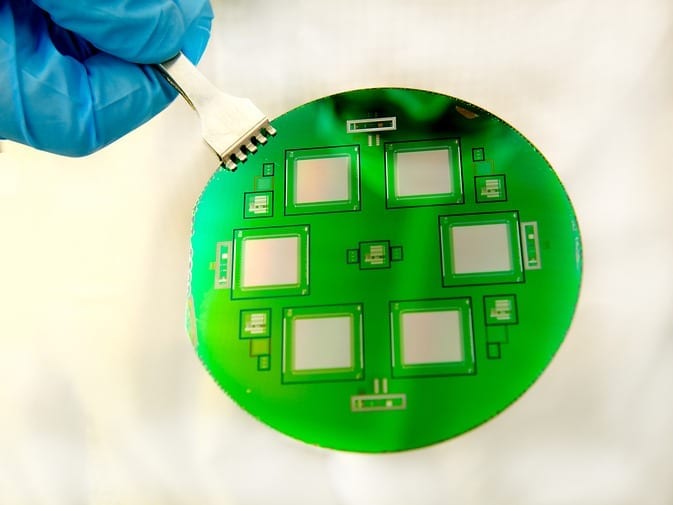
Image Credit: NASA/Bill Hrybyk
NASA technologists have hurdled a number of significant technological challenges in their quest to improve an already revolutionary observing technology originally created for the James Webb Space Telescope.
The team, led by Principal Investigator Harvey Moseley, a scientist at NASA’s Goddard Space Flight Center in Greenbelt, Maryland, has demonstrated that electrostatically actuated microshutter arrays — that is, those activated by applying an specific voltage — are as functional as the current technology’s magnetically activated arrays. This advance makes them a highly attractive capability for potential Explorer-class missions designed to perform multi-object observations.
“We have identified real applications — three scientists want to use our microshutter arrays and the commercial sector has expressed interest,” said Mary Li, a Goddard engineer who is working with Moseley and other team members to fully develop this already groundbreaking observing technology. “The electrostatic concept has been fully demonstrated and our focus now is on making these devices highly reliable.”
Progress, she said, is in large part due to the fact that the team successfully eliminated all macro-moving parts — in particular, a large magnet — and dramatically lowered the voltage needed to actuate the microshutter array. In addition, the team applied advanced electronic circuitry and manufacturing techniques to assure the microshutter arrays’ dependable operation in orbit, Li added.
The Microshutter Breakthrough
Considered among the most innovative technologies to fly on the Webb telescope, the microshutter assembly is created from micro-electro-mechanical technologies and comprises thousands of tiny shutters, each about the width of a human hair.
Assembled on four postage-size grids or arrays, the 250,000 shutters open or close individually to allow only the light from targeted objects to enter Webb’s Near Infrared Spectrograph (NIRSpec), which will help identify types of stars and gases and measure their distances and motions. Because Webb will observe faint, far-away objects, it will take as long as a week for NIRSpec to gather enough light to obtain good spectra.
NIRSpec’s microshutter array, however, enhances the instrument’s observing efficiencies. It will allow scientists to gather spectral data on 100 objects at a time, vastly increasing the observatory’s productivity. When NASA launches the Webb telescope in 2018, it will represent a first for multi-object spectroscopy.
Read more . . .
The Latest on: Microshutter technology
[google_news title=”” keyword=”Microshutter technology” num_posts=”10″ blurb_length=”0″ show_thumb=”left”]
via Google News
The Latest on: Microshutter technology
- Technology & Innovationon May 8, 2024 at 5:00 pm
Technological innovations have produced robots capable of jobs that, until recently, only humans could perform. The present research explores the psychology of "botsourcing"—the replacement of human ...
- Information Technology Newson May 5, 2024 at 5:00 pm
May 6, 2024 — Researchers have achieved the first controllable interaction between two hole spin qubits in a conventional silicon transistor. The breakthrough opens up the possibility of ...
- 10 Best Technology Mutual Funds Of May 2024on May 2, 2024 at 4:03 am
Commissions do not affect our editors' opinions or evaluations. Over the past 10 years, the technology sector has enjoyed stratospheric performance. You can’t even match the tech funds category ...
- Technology and the Interneton May 1, 2024 at 5:00 pm
Randy Travis has released a new song, “Where That Came From,” with the help of artificial intelligence. It’s his first single since he had a stroke.
- Energy Technology Newson April 23, 2024 at 5:00 pm
Apr. 24, 2024 — Estuaries -- where freshwater rivers meet the salty sea -- are great locations for birdwatching and kayaking. In these areas, waters containing different salt concentrations mix ...
- AI has taken over education technology. What will come next?on April 15, 2024 at 5:00 pm
Some of the most innovative companies in education are using generative AI in new ways—while others are tackling some of the industry’s greatest challenges, from labor shortages to student ...
- Truth Social parent company Trump Media & Technology Group to become publicly traded companyon March 22, 2024 at 7:27 am
Shareholders on Friday voted to make Trump Media & Technology Group, the parent company of Truth Social, a publicly traded entity, Fox News Digital has learned. Shareholders voted in favor of ...
- Technologyon February 6, 2024 at 6:50 am
In a new series, we will test the limits of the latest AI technology by pitting it against human experts. Wind turbines can pose a deadly risk to migrating birds, but there are ways to ...
- Technology Enhanced Teachingon November 21, 2023 at 7:10 pm
Academic Technology works with faculty to support their use of technology to enhance teaching and learning. Instructional Technology, Graphics, and Media Systems staff partner with faculty to design, ...
- Financial Technologyon November 1, 2023 at 6:46 am
With a comprehensive portfolio of marketplace technology, surveillance, risk management and regulatory reporting capabilities, the Financial Technology business is established to be a platform ...
via Bing News









